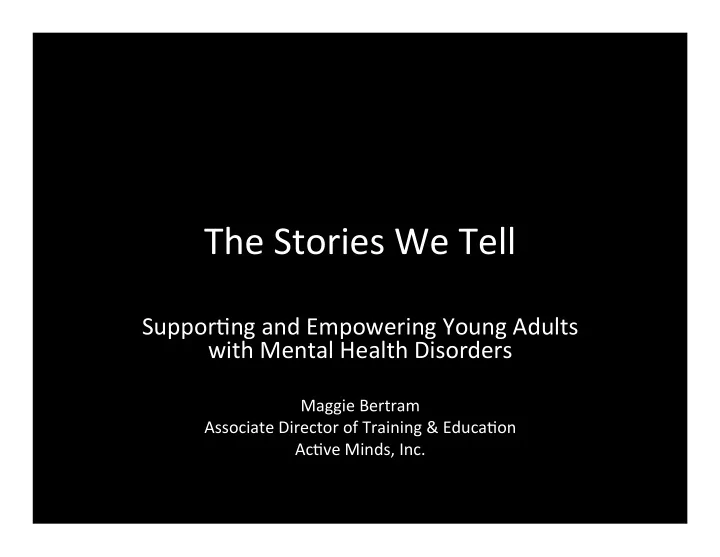

The Stories We Tell Suppor/ng and Empowering Young Adults with Mental Health Disorders Maggie Bertram Associate Director of Training & Educa/on Ac/ve Minds, Inc.
Overview • Introduc/on to Ac/ve Minds • How Stories Heal • Storytelling & Recovery • Iden/ty Development • Our Stories, Ourselves
Ground Rules • Confiden/ality • Par/cipate • Mutual Respect • Safety
Ac/ve Minds, Inc.
Ac/ve Minds, Inc. • Our primary messages: – Everyone has a story – We are the voice – You can make a difference
Ac/ve Minds, Inc. • What are chapters? • What are programs? • Where might you see us?
Ac/ve Minds, Inc. • My roles at Ac/ve Minds – Associate Director of Training & Educa/on – Speaker, Ac/ve Minds Speakers Bureau
Ques/ons about Ac/ve Minds?
Let’s move.
AN ICEBREAKER
How Stories Heal Make a list of characteris/cs of Genera/on Y and Genera/on Z clients.
How Stories Heal Have clients changed significantly since you began your career? If so, how?
How Stories Heal How has the client/therapist rela/onship changed over /me? • What have been the benefits of that change? • What have been the drawbacks?
How Stories Heal What strategies have you found or been taught that enable you to engage more meaningfully with clients?
BREAK
Lessons I Learned from Anxiety, Depression, and Ea/ng Disorders STORYTELLING & RECOVERY
Ques/ons?
Themes?
BREAK
IDENTITY DEVELOPMENT
Young Adult/College Student Development • Iden/ty Development – Who am I? – What is my role? – What does it mean to be in rela/onship with others? – Can I be who I want to be?
Invisible Iden//es • Students with invisible disabili/es • Avoidance / Pre-encounter – First internal awareness of distress – Desire to “just be normal” – Tendency to perform “normal” Corrigan, P.W. & Ma[hews, A.K. (2003). S/gma and disclosure: Implica/ons for coming out of the closet. Journal of Mental Health, 12 (3), 235-248.
Invisible Iden//es • Confusion/Comparison – Ques/oning sanity – Aliena/on – What is normal? • Acceptance – Disclose distress or diagnosis to others Corrigan, P.W. & Ma[hews, A.K. (2003). S/gma and disclosure: Implica/ons for coming out of the closet. Journal of Mental Health, 12 (3), 235-248.
Invisible Iden//es • Immersion – Become immersed in cultures of consumer / survivor – Rejec/on of dominant culture Corrigan, P.W. & Ma[hews, A.K. (2003). S/gma and disclosure: Implica/ons for coming out of the closet. Journal of Mental Health, 12 (3), 235-248.
Invisible Iden//es • Empowerment/Synthesis – Fully commi[ed to and engaging in treatment – Begin to think beyond their treatment – Learning skills for their recovery – Making choices about their future path • May begin to consider advocacy or mentoring • May choose to never revisit this experience Corrigan, P.W. & Ma[hews, A.K. (2003). S/gma and disclosure: Implica/ons for coming out of the closet. Journal of Mental Health, 12 (3), 235-248.
The development of one’s iden/ty is a never ending story.
INCORPORATING PERSONAL NARRATIVE
Coming Out • What are the different reasons a client may want to tell someone about their diagnosis? • In what environments or via what modali/es might clients share their stories? • What is your preferred method of disclosing personal informa/on?
Transi/on from Treatment to Recovery • The Power of Reflec/on • The Truth is in the Telling • Sharing Stories to Empower
OUR STORIES, OURSELVES
Our Stories, Ourselves Percep/on: • A story must have a defined beginning, middle and end. Percep/on: • Stories have to meet a set of standards to be told.
Overview • Ground Rules • Using Stories Effec/vely • Developing Stories • Overcoming Challenges • Storytelling • Wrap-up & Next Steps
The Most Important Things to Know YOU have a story worth telling because EVERYONE has a story worth telling.
How We Use Stories • Have you heard great mental health stories? – What made them great? – Why were they being told? What was the mo/va/on?
How We Use Stories • What makes a mental health story unsuccessful? • Common Piialls
The First Five Minutes • Find a buddy. • Jot a few notes (2 minutes). • Your five minutes starts…NOW!
BREAK
Debrief • Which of these came out organically? – Background informa/on – The “Oh, WOW!” or “Whoa, what?” moment – Other characters (than yourself) – Educa/onal messages – Explana/on of what was at stake
Gemng Informa/ve • Messages to incorporate – Consider your purpose – Don’t force it – What do you want others to learn?
Tips and Guidelines • Establish your “Oh, wow.” moment • What significant events led to this moment? • What significant events followed this moment?
Tips and Guidelines • What was at stake? • What educa/onal messages are significant? • What is the takeaway?
WRITING TIME
The Next Five Minutes • Re-group. • Your five minutes starts…NOW!
How was it? • How did you story evolve? • How might you use your story in the future? • How might your clients use this method as they progress through their recovery?
Maggie Bertram maggie@activeminds.org
Recommend
More recommend